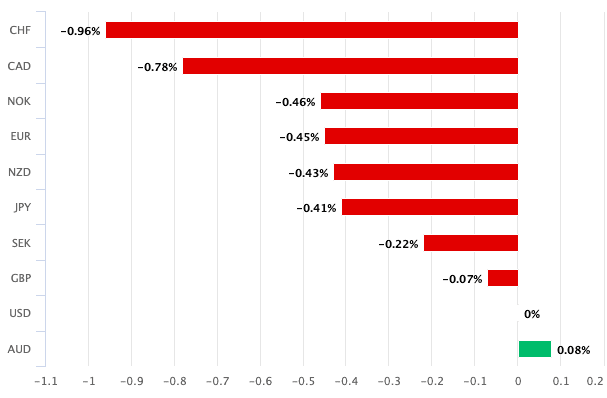Dollar's Safety Bid to Fade, but Euro-Dollar Rate Upside to Remain Limited says Barclays and Wells Fargo
- Written by: Gary Howes
-
- Covid Delta fears overblown says Barclays
- Chinese economy to underpin global growth
- See USD demand fading
- Wells Fargo says EUR/USD upside is limited

Image © Adobe Images
- EUR/USD reference rates at publication:
- Spot: 1.1885
- Bank transfers (indicative guide): 1.1467-1.1550
- Money transfer specialist rates (indicative): 1.1776-1.1800
- More information on securing specialist rates, here
- Set up an exchange rate alert, here
Fears over global growth slowing and the impact of the Delta variant look overblown, meaning the Dollar's recent safe-haven bid is unlikely to last according to new currency market research.
But analysts at Wells Fargo and Barclays say although the Dollar has limited upside scope, the Euro is unlikely to be an outright beneficiary as it faces its own idiosyncratic headwinds
Barclays says the Dollar is likely to see safe-haven demand recede over the near-term as investor concerns over rising Covid cases and a Chinese slowdown prove overblown.
"We expect safety demand for dollar to recede over time," says Juan Prada, foreign exchange analyst at Barclays in a regular weekly research briefing.
Such safety demand was on display on July 19 when global markets suffered sharp declines amidst concerns the Delta variant of Covid-19 would slow the global economic recovery, and a look at major markets in early August suggest the impact of these declines is yet to be be fully reversed even as sentiment makes a steady recovery.
Indeed, outbreaks in China and the U.S. are being monitored by investors as cases in the UK and much of the Eurozone fall.
"Concerns about the renewed spread of the virus have re-emerged. Should the increase in COVID cases, in the U.S. and internationally, become more widespread and persist for an extended period, the greenback would likely remain supported. That would particularly be the case if COVID concerns led to more meaningful and ongoing weakness in equity markets," says Nick Bennenbroek, International Economist at Wells Fargo Securities, LLC.

Above: Is Dollar demand already waning? USD performance over the past week.
Secure a retail exchange rate that is between 3-5% stronger than offered by leading banks, learn more.
But for many economists, those countries with high vaccine penetration are likely to be unfazed by the Delta wave; a stance emboldened by the UK's experience where cases have started to come down despite the full lifting of restrictions.
The variant is therefore now being considered to be a greater threat for countries that have high proportions of unvaccinated people, suggesting an idiosyncratic approach to the market is now required.
"New waves of COVID-19 infections are increasing downside risks for countries with lagged vaccination efforts. Given that severity of illness appears contained in countries with high vaccination rates, differentiation in FX markets based on this is likely to continue. However, with continued vaccination progress, especially in G10, we do not expect the new waves of pandemic to derail the global economic recovery significantly," says Prada.
But it is not just Covid that is registering as a consideration for risk sentiment: the Dollar's safe haven credentials were once again in demand towards the end of July amidst a global sell-off in stocks linked to a an ongoing crackdown by Chinese authorities on technology stocks.
"The China internet space has been weighed down by regulatory uncertainties since the Ant IPO suspension in November last year. The recent crackdown on ride-hailing app Didi ahead of its US listing, adds to the list of actions taken by the Chinese regulators to curb anti-competitive practices by companies in this space," says Mislav Matejka, an analyst with JP Morgan.
The developments prompted global investors to reduce exposure to China, which lead to an inevitable drawdown in broader markets and stoked demand for the Dollar.
Wells Fargo meanwhile maintain a view that U.S. Dollar strength is to persist "for the time being", but U.S. dollar softness over the medium-term is expected.
"However, there is a risk that U.S. dollar strength could be longer-lasting over time," says Bennenbroek.
{wbamp-hide start}
{wbamp-hide end}{wbamp-show start}{wbamp-show end}
Jitters concerning China come as markets are already cautious on a broader slowdown in the Chinese economy that has been underway for some months.
"China’s latest regulatory crackdown has triggered financial market turmoil, and the tightening of policies is likely to slow the expansion of the IT sector, keep headwinds for consumption and recreation in H2, and pose downside risks to the domestic financial sector," says Prada.
However, Barclays believe the negative effect on growth should not be overstated, as the coordinated crackdown reflects government efforts to guide resources away from the internet/tech sector into the core tech sector and to address social issues and data security concerns, rather than to slow the economy meaningfully.
Indeed, economists at the bank continue to expect China’s growth in 2021 (+8.5%) to be the strongest in the major economies.
But Barclays caution "any unwind of the USD bid is likely to be gradual and with two-way volatility."
With regards to the Euro-to-Dollar exchange rate's outlook, Barclays say the Dollar’s reduced safe-haven bid suggests EUR/USD’s near-term direction is higher but scope for Euro-Dollar gains is ultimately limited.
"An absence of significant domestic risk events will leave EURUSD trading in the winds of global risk sentiment this week. However, the EUR will likely not be the biggest beneficiary of our call for a weaker dollar near term," says Prada.
Like Barclays, Wells Fargo anticipate any Euro-Dollar gains linked to a medium-term Dollar retreat to be relatively limited.
"We forecast only mild gains in the euro over time, and see the risks as tilted toward even smaller gains, or possibly even outright declines, versus the U.S. dollar," says Bennenbroek.
The European Central Bank (ECB) is seen to be a particularly strong headwind to meaningful gains by the single currency, given the central bank looks set to be one of the last to raise interest rates.
Money market pricing suggests the ECB will only raise rates in 2024 at the earliest, years behind the Bank of England, U.S. Federal Reserve and the majority of G10 central banks.
"The ECB's new policy target and more dovish guidance could lead to even more accommodative monetary policy than we currently forecast, which should weigh on the euro," says Bennenbroek.
Wells Fargo forecast the Euro-Dollar exchange rate will end 2021 at 1.17.
Barclays also cite the EBC has being a headwind to Euro appreciation potential.
"The ECB’s new mandate and updated interest rate forward guidance mean the ECB will greatly lag its global peers in normalizing policy. While the eurozone economic recovery is in train, it is also increasingly priced into markets," says Prada.
